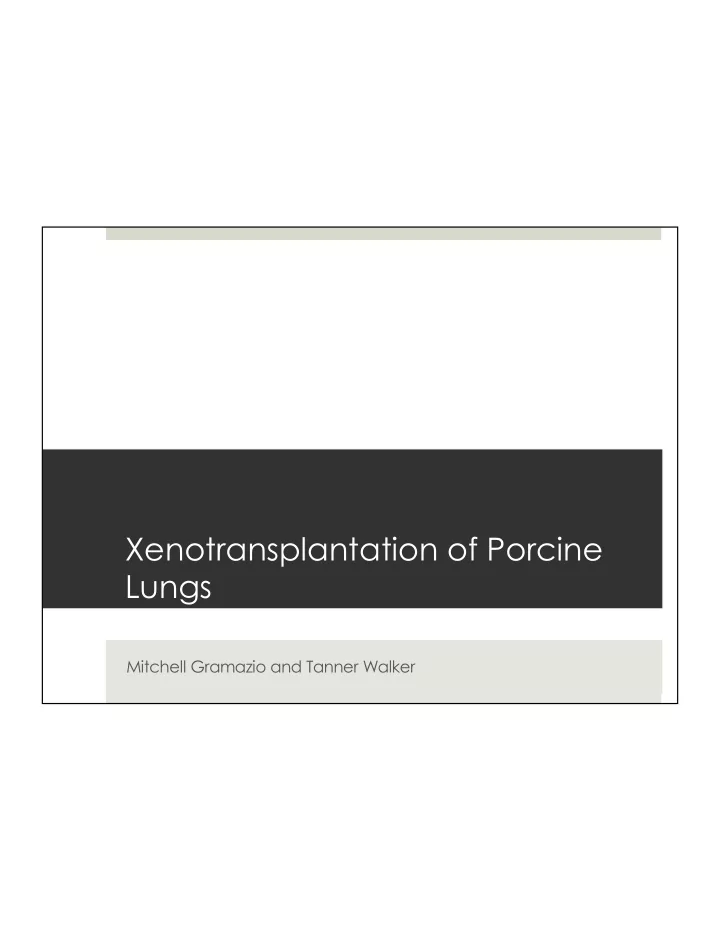

Xenotransplantation of Porcine Lungs Mitchell Gramazio and Tanner Walker
How many people do you know have lung problems?
Population Affected by Lung Problems ¤ Lung Cancer in the U.S. (2011) † ¤ 207,399 diagnosed ¤ 156,953 died †Source: U.S. Cancer Statistics Working Group. United States Cancer Statistics: 1999–2011 Incidence and Mortality Web-based Report. Atlanta (GA): Department of Health and Human Services, Centers for Disease Control and Prevention, and National Cancer Institute; 2014.
What’s the big picture? ¤ Think about future endeavors in the field of xenotransplantation ¤ Why xenotransplant a lung? ¤ Where to go from here?
Why Xenotransplantation? ¤ Xenotransplantation ¤ Transplanting any biological tissue, in this case organ, from one species to a different species. ¤ Possibility of providing a fix to donor shortages across the medical field by utilizing livestock that are abundant in numbers.
What is the paper proving? ¤ Difference between H 0 and a hypothesis ¤ H 0 – It is not possible to overcome immunological barriers when xenotransplanting porcine pulmonary lungs to an ex vivo model of a human biological system.
Key Terms ¤ Wild Type ¤ Pulmonary Vascular Resistance (PVR) ¤ Hyperacute Rejection ¤ Homologous Recombination ¤ GTKO - α 1,3-galactosyltransferase gene knockout
Methods – Generation of Transgenic Pigs ¤ Transgenic pigs produced through homologous recombination ¤ CD55-59 expression generated through oocyte microinjection ¤ CD39 expression generated through transfection in pig fetal fibroblasts
Methods – Surgical Technique ¤ Lungs obtained through cross-bred Large White/Landrace pigs after being anesthetized, intubated, paralyzed and ventilated.
Methods – Ex Vivo Lung Rig ¤ Lung and heart were set up with a mechanical ventilator, centrifuge pump and membrane de- oxygenator.
Methods – Study Design ¤ 6-hour time period (240 minutes) ¤ Perfusion of Steen solution Contains Human Serum Albumin (Type-A) ¤ Dextran ¤ Extra-cellular K+ (electrolyte) ¤ ¤ 600 mL Steen solution ¤ 10 Experiemnts 3 Wild-type ¤ 2 GTKO ¤ 3 GTKO/CD55-59 ¤ 2 GTKO/CD55-59/CD39 ¤
Methods – Tissue Biopsies ¤ Immunohistochemistry used to determine if coagulation activation occurs among… ¤ IgG ¤ IgM ¤ C3 ¤ C5b-9m ¤ CD6 ¤ C4d
Methods – Assessment of Perfusate ¤ Perfusate was assessed for levels of… ¤ Neutrophils ¤ Lymphocytes ¤ Monocytes ¤ Macrophages ¤ Platlets
Methods – Statistical Analysis ¤ ANOVA and Chi-square tests performed on data ¤ Statistical significance was defined as p < 0.05
Data - 1 • What is shown here? • Are there any trends? • What conclusions can be made based on these data?
Data - 2 • What is shown here? • Are there any trends? • What conclusions can be made based on these data?
Data - 3 • What is shown here? • Are there any trends? • What conclusions can be made based on these data?
Data - 4 • What is shown here? • Are there any trends? • What conclusions can be made based on these data?
Results ¤ After the addition of human blood… ¤ All WT lungs failed rapidly (21 +/- 4 mins) ¤ All but one genetically modified lung succeeded (240 mins)
Failed Tests ¤ All WT Lungs ¤ One Genetically Modified Lung ¤ Why? ¤ Hyperacute Rejection ¤ Antibodies in the introduced human blood
Successful Tests ¤ 6 Genetically Modified Lungs ¤ Why? ¤ No rejection from antibodies in the introduced human blood ¤ No attack complexes found ¤ Possible result of CD39, CD55 and CD59.
Conclusions - 1 ¤ After looking at the scatter plot with variables dAV Oxygenation/mmHg (Independent) and Perfusate Platelet Count % change (Dependent)… ¤ R 2 = 0.64 ¤ p < 0.01 ¤ What does this mean statistically?
Conclusions - 2 ¤ What do these results say about H 0 ? ¤ Due to great statistical significance (p < 0.01), we can reject the null hypothesis. ¤ But what does that mean?
Questions?
Recommend
More recommend